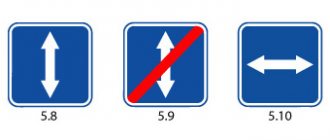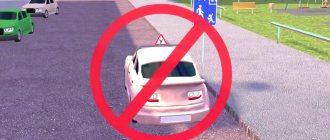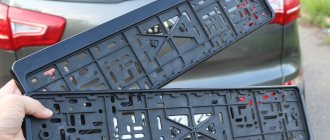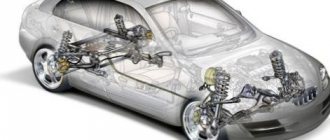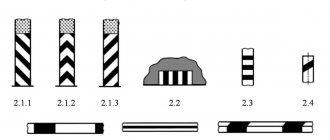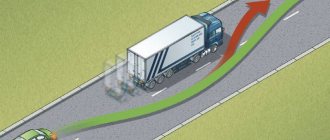It is known that the carriageway along its length in different places may have different widths sufficient for traffic. Depending on the organization of traffic along the lanes, the nature of road intersections (junctions, road junctions, etc.), the type of engineering structures (bridges, overpasses, tunnels, etc.), as well as temporary road works, both expansion and contraction can be observed roadway.
In places where the width changes, appropriate road signs are installed, or not installed if their absence does not cause ambiguity in the interpretation of the road situation.
What does the road narrowing sign mean and what does it look like?
Road narrowing belongs to the category of warning signs and is installed:
- In the city, according to traffic rules, it is installed at a distance of approximately 100 meters from the beginning of the site
- Outside the city on the highway at a distance of an average of 200 meters.
- Outside the populated area, it is re-installed 50 meters before the dangerous area.
Even people who graduated from driving school a long time ago and may have forgotten some traffic rules will understand it. After all, there is nothing complicated in its structure. The sign itself looks like a triangle with a red border and signals a decrease in the number of lanes and the need to change lanes.
If a road sign has an unusual yellow background, this means it is temporarily in this place and is installed in places where road work is being carried out. But there are times when the one established in this place and the temporary one contradict each other. In this situation, you should be guided by temporary signs.
Types of road narrowing sign
It has three different types:
- 1.20.1 - the road narrows both on the right and on the left,
- 1.20.2 - the road narrows on the right,
- 1.20.3 - the road narrows on the left.
They all look almost the same.
Signs warn the driver that one of the lanes will soon end and there is a need to change lanes. Usually the sign is also accompanied by markings on the road, but if there are none, you should pay more attention to the signs.
1.20.1 - narrowing of the road on both sides is much less common than 1.20.1 and 1.20.2. It happens that a three-lane road turns into a one-lane one. In this case, you need to be even more careful, because cars change lanes on both the right and left into one lane, and you will need to know who is giving way to whom when changing lanes.
This is interesting: Do-it-yourself car alarm repair
Varieties of sign
Here we are talking about signs 1.20, of which there are actually 3. And they have slightly different appearances, installed in appropriate situations. In the photo you can clearly see the difference.
The point of the sign is that two lanes merge into one. The only question is that there is an acceleration lane, and there is another narrowing lane. That is, they move straight along one, and perform a maneuver along the other. But there is an exception in the form of the third sign, where the maneuver is provided from two lanes at once, which begin to narrow. I think it is about this sign that the greatest number of disputes and conversations arise.
As for the signs themselves, they are presented in the form of a red triangle with a white background. The background can also be yellow, which means the sign is temporarily located in this area. They are installed during repair work.
When the repair is completed, the structure is removed and it ceases to function.
But the image inside the triangle comes in 3 types. Hence the division into subcategories of the sign.
- 1.20.1. Such an indicator is presented in the form of the same triangle, inside of which 2 black stripes narrow. From expansion begins contraction. This means that change occurs on both sides;
- 1.20.2. Here the left black stripe remains straight, and the right one is curved. I think it’s not difficult to understand that the narrowing occurs on the right side;
- 1.20.3. The situation is the opposite of the previous one. The left stripe is straight, and the right one tapers.
There are different signs on the roads. From them, the driver can understand in advance that there will be a narrowing ahead. Moreover, some motorists must change lanes or yield to other drivers, depending on where they are moving and in which lane.
This makes it possible to regulate the flow of cars on sections of roads that narrow.
The narrowing can be permanent or temporary. In the first case, the pointer will have a white background, and in the second, yellow.
Signs are located at a distance of 50 to 100 meters from the narrowing itself, if it is located within a populated area. Outside populated areas, according to the rules, the sign must be placed at least 150 and maximum 300 meters away.
There are also large cities where such signs are located specifically at public transport stops. According to traffic regulations, drivers do not have the right to enter there, since this is a designated area for public transport where passengers pick up and drop off. A smart solution for security purposes.
Lack of signs and markings
The situation is not uncommon when there is a narrowing, but it occurs without a sign or marking. This is a huge flaw in the responsible services.
If you doubt the correctness of your actions, if there are no signs and markings, just imagine that they are there. This will make it easier to make the right decision.
You should not rely on the fact that due to a missing sign you can violate the rules of the signs in question and the traffic priority rule if you are fined or you become the culprit of an accident. So, this may somewhat influence the court's decision. But at the same time, even the absence of a sign or markings does not relieve one from responsibility for failure to comply with the rules on the need to give way to passing vehicles that do not change their direction.
Subscribe to updates and receive articles by email!
We guarantee: no spam, only new articles once a week!
Good afternoon, dear car enthusiasts!
In this material we will consider the issue of priority when narrowing the road. With proper organization of traffic, the narrowing of the road is indicated by appropriate signs and markings, however, in practice, it is not uncommon for drivers to find themselves in a “neck” in the absence of means of organizing traffic.
For example, take the narrowing of the road at a bend.
Cars moving in two rows in the same direction are forced to divide the remaining lane among themselves. There are only two options, either the white car is inferior, or the blue one.
Basically, for this situation, drivers apply one of two points of the Rules of the Road.
Some people consider this a rebuild:
8.4. When changing lanes, the driver must give way to vehicles moving in the same direction without changing direction. When simultaneously changing lanes of vehicles moving in the same direction, the driver must give way to the vehicle on the right.
For others, this situation is not regulated by the rules and they apply clause 8.9 of the traffic rules:
8.9. In cases where the trajectory of vehicles intersect, and the order of passage is not specified by the Rules, the driver to whom the vehicle is approaching from the right must give way.
Arguments for gaining an advantage from a white car: “I’m moving in the left lane, there are no obstacles in this lane, I’m not maneuvering, I’m not changing lanes, the blue car is changing into the left lane.
Arguments for gaining an advantage for the blue car: “The road is narrowing, two lanes end, only one remains and both cars simultaneously change lanes into this remaining lane” or “In this case, the order of passage is not specified by the rules, and the one with the obstacle on the right gives way "
It turns out that both cars have the right to count on an advantage, but this cannot happen. Therefore, let's analyze this road situation in detail. First, for convenience, we will “straighten” the road, since the bend itself has no direct relationship to the number of lanes on the road. From the point of view of the Road Traffic Rules, driving along a curved road is straight. All direction changes are made relative to the direction of the road. The fact of narrowing is important, but the narrowing along the radius or along the straight line does not matter.
Legal assistance in case of violations and accidents
Road disputes are one of the most common today; drivers often get confused due to the installation of contradictory signs, misunderstand the rules and find themselves in difficult situations due to a number of additional nuances. As practice shows, all cases are individual and therefore require detailed consideration from a legal point of view. Therefore, if you get into an accident or disagree with a traffic police officer who has accused you of a violation, it would not be a bad idea to seek help from a lawyer specializing in motor vehicle law issues. He will help you understand the situation and find the right way to resolve the issue.
0
0
0
0
0
1
Directions.
The Traffic Rules do not limit directions to driving straight ahead - this is important. There are four directions of movement:
- Directly
- Right
- Left
- Reverse direction
The next important point is that the direction of movement is determined relative to the direction of the road. If a road physically changes direction, then the direction of travel on that road does not change. Driving on a winding road is, within the framework of the Road Traffic Regulations, driving straight. For example, there is no need to turn on your turn signals, stay in an extreme position, or comply with other regulations related to maneuvering, because you drive straight regardless of changes in the actual direction of the road. You are moving along the road. Where the road goes, so do you.
Please note: In the text of the rules, the same concepts can be used both in the generally accepted understanding and in accordance with the definitions. For example:
A turn is a maneuver described in Chapter 8 of the rules as a change in the direction of movement on the roads and a turn in the generally accepted sense, indicated by the signs “Dangerous turn” or “dangerous turns”, as an actual change in the direction of movement.
Stopping is an action defined by the Rules of the Road, and an actual stop when the speed of movement becomes zero (in a traffic jam or in front of a traffic light). The same goes for directions.
Why does the stripe “disappear”?
Outside populated areas, road signs are installed at a distance of 150–300 meters so that the driver has time to react. After all, the speed on the highways is higher than in the city. Therefore, for the safety of all road users, signs are installed in advance. In a city or other populated area, the sign can be seen 50–100 meters before the place where the maneuver will need to be performed. In other situations, the sign may be located at a different distance, regulated by traffic rules. The reasons why a restrictive sign is installed may vary. For example, a new asphalt road flows into an old road, which is one meter narrower. Or the road is reduced in width due to man-made structures such as a bridge or overpass. Also, when entering the highway to accelerate the car, before wedging into the flow, an acceleration lane is provided, the end of which will be signaled by the road sign “Narrowing of the road on the right.” It is worth taking into account the savings of road workers, who, in the absence of a large traffic flow, simply will not maintain an extra lane. In the city, narrowing most often occurs where public transport stops. In such a situation it will not necessarily be indicated by a sign. Usually road workers limit themselves to markings, especially since this does not contradict traffic regulations.
When is it okay not to give way?
You may not give way in the following cases:
- at an unregulated intersection when moving along the main road (except for pedestrians who have entered an unregulated pedestrian crossing);
- at a controlled intersection when moving on a green light in the forward direction (except for a tram, also moving on the main green light);
- at the intersection of equivalent roads if you intend to turn right (except for pedestrians) (there is no need to yield, since there is no obstacle on the right);
- when the road narrows, you do not need to yield if you continue to move in your lane without changing direction.
Cases when you may encounter this sign
Situations on the road are different. This sign can be found:
- in the city
- outside the populated area.
But it is quite difficult to find it in the city; it is usually replaced by road markings.
So, the main cases when you may encounter this sign:
- The sign is found in those places where one of the stripes ceases to exist. And it’s good if you know this section of the road and can change into the desired lane in advance, but for drivers who drive here for the first time, narrowing the road can cause a lot of trouble in the city. For example, you are driving through the city and see a narrowing road in front of you. You are faced with the need to change lanes, but there is a dense flow of cars in the adjacent lane, which does not give you room to maneuver. And you have to either slow down too much, or stop completely and wait until they let you pass or there is enough distance between the cars so that you can change lanes. But don't forget to turn on your turn signals when changing lanes.
- This sign can also be found at road work sites. As we said, its difference is the yellow background of the sign. In this case, the lane on the road is simply fenced off by road workers and it becomes temporarily inaccessible for traffic.
- The sign is installed in places where you exit from a minor road onto a wide highway or avenue.
- The sign can also be found before passing under a bridge, where the road usually narrows from several lanes in one direction to one lane.
Situations where there is no warning sign
There are also situations when there is no sign and the road narrows. What to do in this case? It's quite simple. You must follow other travel rules.
Considering that your lane is ending, when changing lanes you must give way to other cars moving without changing direction.
This is stated in rule 8.4, because when you change lanes into an adjacent lane, you will be an obstacle for other cars. And don't forget to turn on your turn signals to give advance warning of your maneuver.
This is interesting: What is the fine for driving on the sidewalk in 2021
What to do when passing a sign “Narrowing the road in both directions”
Much more ambiguity arises when passing a sign indicating that the road is about to narrow on both sides - in such cases, deciding who should pass and who should have the right of way is not so simple.
If the road is three-lane, then everything is quite obvious: the driver moving along the middle one has no obstacles. Vehicles driving on the left and right should merge into the middle lane whenever possible, giving way to drivers traveling in a straight line.
If there are only two stripes, that is, the rows gradually merge exactly in the middle, and not one joins another, then the “right hand” rule comes into play here. That is, the driver driving on the left must give way.
Separately, it is worth mentioning situations when a narrowing of the road surface occurs in the absence of an appropriate remote control. This happens very rarely, especially in urban areas, but on a country highway you may well find yourself at the scene of an accident, when the traffic police officers have not yet had time to arrive at the scene and put up a temporary sign. A so-called “neck” arises, and there may be no road markings outside the city. In such a situation, one should be guided by the same rule as if the sign was present - the lane on which the congestion occurred should be perceived as disappearing. But often the application of rules for driving through narrowing roads is impossible for one simple reason - due to the large congestion of traffic, it is impossible to understand which lane should disappear until the car reaches the place of congestion. That is, it will not be possible to change lanes in advance, especially if you do not have sufficient driving experience.
Features of the “Give Way” family signs
Like most other warning signs, signs indicating a narrowing of the roadway are triangular in shape with a white background and a wide red border around the perimeter. Inside the sign there are pictograms of two stripes. If the taper is on both sides, both stripes will be curved with a taper at the top. With a one-sided reduction, one of the stripes will be straight, and it will be located on the side where the narrowing is not expected. This designation is intuitive and means that if you are driving from a straight lane, you have the right of way because you are moving straight.
If the road narrows on the left side, this means that traffic moving along it will have to change lanes to the adjacent right lane, and vice versa. If a two-way narrowing is expected, both the left and right columns will have to change lanes to the central lane.
In any case, those drivers who are driving in the lane to which they need to change lanes have an advantage. In most cases, the interpretation of this family of signs does not cause ambiguous interpretation.
Varieties of the “Narrowing Road” sign
Approach to a road narrowing section: who should give way?
It all depends on the situation, on which side the road narrows. There are no hard and fast rules. The rules for all situations are standard and everyone must follow them. If the road ahead narrows, cars drive in two rows; those who do not need to change lanes should pass first.
For example, if there is a narrowing ahead, but this does not affect the driver’s road position in any way, he does not need to change lanes because of this, he does not have to wait for anyone and let anyone pass, he can safely pass. If, due to a change in the width of the roadway, he needs to change lanes in order to pass, he must wait until those motorists who do not need to change their position pass.
But, do not worry that you will have to wait until all the cars in the next row have passed, because their number can be huge and even endless if it is some kind of busy highway with a lot of car traffic. Don't forget about car ethics. Drivers in the lane where there is no need to change lanes deliberately leave distances between each other and do not drive closely together, so that cars from the adjacent lane have the opportunity to change lanes and wedge into their lane. You must remember to turn on the turn signal if you need to change lanes and get into another lane in order to avoid emergency situations. There is nothing complicated. The main thing is that all motorists remember the rules. Otherwise, an emergency situation may arise. And no one needs this.
There may be several lanes on a narrowing road. Regardless of how many there are, the cars that don’t need to change lanes pass first, and only then the rest. This is the main rule that must be followed if there is a “Narrowing road” sign.
A good video on the topic: Narrowing of the road, who gives way?
Did you like the article? Subscribe to updates via RSS, or follow updates on VKontakte, Odnoklassniki, Twitter or Google Plus. Receive updates directly to your email: Tell your friends! Share the article with your friends on your favorite social network using the buttons on the panel.
Tapering options
The driver’s actions in a situation with the signs in question directly depend on which side the narrowing will occur.
- If the situation narrows on the right, that is, the right lane on the sign is curved, then those moving along this lane, that is, on the right, are required to change lanes. They should carefully move to the left;
- If the narrowing is on the left, then on the contrary they will have to go to the right;
- When the situation forces you to narrow on both sides at once, the transition is simply to the middle lane.
During the maneuver you should be extremely careful and careful. Are you moving from your lane to the next one? Then it is the adjacent lane that is now the main one, and you must give way to drivers moving along it.
If, in accordance with the sign, your lane does not narrow, but the neighboring one does, then you must be allowed to pass on the left or right, depending on the type of sign installed.
Bilateral narrowing involves the use of the same rules and principles. Whose streak ends first is the one who misses.
Narrowing left/right: who must give way
Although it would seem that there should be no misunderstanding here, in reality everything is not so simple. The reason here lies not so much in ignorance of traffic rules, but in the habit of interpreting the situation from the point of view of the widespread “right hand” rule. The problem is that this principle only applies to the rules for driving through intersections, and in this case we are dealing with the movement of a parallel stream of cars traveling in the same direction on an absolutely flat section of the highway. If the road narrows on the left, then the notorious rule works correctly. But if the arrow on the sign indicates that the right lane is subject to reduction, here you need to be guided by the fact that the left row of cars moves without interference, but you will have to brake and wedge to the left only if there is a “window”. If the traffic is heavy, this may take a long time, but rushing is unacceptable. And even more so - self-will, which undisciplined drivers often resort to.
However, the Rules stipulate such cases, and if, for example, in the area covered by the sign “Narrowing of the road on the right,” a cluster of vehicles has formed due to the impossibility of wedging into the left lane, the traffic rules instruct drivers moving in the left lane to let neighboring cars pass. But we are not talking about quantitative regulation, so such issues are resolved primarily on the principles of driver solidarity. If you see that there is a traffic jam on the left or right, no one is stopping you from slowing down and letting a few cars pass in order of priority. If the rear drivers do the same, the queue will dissolve as it arises.
Of course, this does not mean that if a “Narrowing road” sign looms ahead on the left or right, then you should drive along the disappearing lane all the way in order to hope for manifestations of driver ethics.
You need to look in advance to see if there is an opportunity to merge into the adjacent lane, and be sure to do this whenever possible.
Rules for such a maneuver
The procedure for simultaneous and single changes of cars from row to row is regulated by paragraph 8.4 of the traffic rules.
It contains the following requirements.
- If a car is driving in the right lane and wants to continue driving in the left lane, the driver must make sure that his maneuver is safe and turn on the appropriate turn direction indicator light. Moreover, if another car is driving on the left (interference on the left), then it has priority. It follows from this that the obstacle on the left must be passed forward, and only after that, after making sure it is safe, carry out the above maneuver.
- If a car is moving in the left lane and wants to change lanes (make a maneuver) to the right lane, then the driver must turn on the turn signal and make sure that there is no obstacle on the right (another vehicle), and then move. In this case, the car that is driving in the other lane (obstacle on the right) has the advantage, so you need to let it pass, and then just carry out the maneuver.
Such rules are established so that you can safely change lanes. This is not a difficult maneuver, but it requires maximum attention from the driver and the choice of a certain speed limit.
In addition, drivers must carefully monitor the road situation and choose the optimal speed limit. That is, even if someone violates traffic rules and creates an emergency situation, they should try to avoid an accident by correct maneuvering.
Who has the right of way when the road narrows?
In principle, these are all the signals that the system of signs and markings gives the driver. But some perceive them as an advantage for rebuilding. Like, everyone should let them through, because it’s not their fault that “the road ends.”
Absolutely not. On the contrary: you must let everyone through, and when a gap appears, carefully fit into the flow.
Two men had a fight in the comments under a video about traffic violations - now one is in the morgue, and the other is in custody
All! No advantages, everything is fair. Being forewarned means taking action and changing lanes in advance if there is a convenient moment. But there is no need to “stand” at the end of the lane, sometimes this leads to serious accidents.
Interference on the right when turning and driving through intersections
At the exit from large populated areas, as well as in the center of some smaller urban areas, unregulated intersections are very common. There are 2 types of them: unequal and equivalent intersections. But how should we proceed in this case?
Equivalent intersections
The driver of a trackless vehicle, in this case, can fully use the right-hand rule, having previously let the rail vehicle pass. The obstacle on the right when turning is taken into account by all traffic participants in this section. We have previously written in detail about the passage of vehicles at unregulated intersections.
Uneven intersections
For convenience and correct passage, you should first study the road signs when approaching the junction. The first to leave such a section are the rail workers located on the main road. Next are trackless vehicles that are on the main road (when crossing, we use the right-hand rule). Only then can participants on the secondary road pass each other in the same order (first rail vehicles, then trackless vehicles).
Installing a Chinese din radio in a car: how to do it yourself
But sometimes changes in the width of the road surface on the right or left force you to wait for a long time, allowing motorists to pass in the priority lane. If it is a busy highway with huge traffic jams, according to the rules you will still have to wait. But there is a concept of driver ethics. It provides that the driver can stop, letting cars pass from the narrowing lane, in order to relieve the situation a little. If you are missed in a heavy traffic, don’t forget to say thank you. This is done extremely simply by turning on the emergency lights for a few seconds.
I think there is nothing complicated here. Those who remain in their lane calmly continue moving, do not wait for anyone and do not let anyone through.
When there is a narrowing in your lane, you wait and let it pass. Everything is elementary.
Fine for violating traffic rules when passing a “Narrowing road” sign
Drivers are different. Some are disciplined, others allow the possibility of minor violations. Some are always concentrated and extremely attentive, others rely on intuition, constantly talking on the phone or with passengers. Some have an instant reaction that allows them to get out of the most dangerous situations unharmed, while others need a little more time to correctly navigate a difficult traffic situation.
If everyone were the same, there would most likely be no traffic accidents. But the reality is that none of us is immune from making mistakes, including those related to the rules for driving sections of the road on which the “Narrowing of the Road” DZ is installed. There is no need to talk about the seriousness of the punishment for such offenses - according to Article 12.014 of the Administrative Code, it involves the imposition of a standard fine (500 rubles). Unfortunately, this does not provide any significant incentive for drivers to strictly observe the order of travel in controversial situations.
